V-Tach vs V-Fib: How to Recognize and Respond
For every nurse, RN nurse, or nursing student preparing for the NCLEX, cardiac arrhythmias are a must-know. Among the most critical are ventricular tachycardia (V-Tach) and ventricular fibrillation (V-Fib). Both rhythms can be life-threatening; therefore, a quick and accurate response is essential in both clinical practice and exams. This guide not only simplifies the differences but also provides nursing notes you can easily add to your nursing bundle for review.
🔹 What is Ventricular Tachycardia (V-Tach)?
Definition: A rapid heart rhythm originating in the ventricles.
ECG Signs: Wide QRS complexes, rate usually >100 bpm, regular rhythm.
Patient Presentation: The patient may be stable (with a pulse) or unstable (hypotension, dizziness, chest pain). However, if left untreated, V-Tach can deteriorate into V-Fib.
Key Nursing Notes:
- First, check for a pulse immediately.
- If a pulse is present but the patient is unstable → prepare for synchronized cardioversion.
- If a pulse is present and the patient is stable → administer antiarrhythmics such as amiodarone or lidocaine.
- In addition, always monitor closely and prepare for advanced interventions.
🔹 What is Ventricular Fibrillation (V-Fib)?
Definition: Chaotic, disorganized ventricular activity in which the ventricles quiver and no blood is pumped.
ECG Signs: Irregular, wavy baseline with no identifiable P waves, QRS, or T waves.
Patient Presentation: In contrast to V-Tach, V-Fib is always pulseless, unresponsive, and not breathing normally.
Key Nursing Notes:
- Immediate CPR is required.
- Furthermore, defibrillation should be performed as soon as possible (unsynchronized shock).
- Follow ACLS protocols step by step: shock → CPR → epinephrine → amiodarone.
🔹 V-Tach vs V-Fib – Quick Comparison
| Feature | Ventricular Tachycardia (V-Tach) | Ventricular Fibrillation (V-Fib) |
|---|---|---|
| ECG Rhythm | Wide, regular QRS | Chaotic, irregular baseline |
| Pulse | May be present or absent | Always absent |
| Patient Status | Can be stable or unstable | Always unresponsive |
| Treatment | Antiarrhythmics or cardioversion | CPR + Defibrillation |
| NCLEX Focus | “Check pulse first” | “Start CPR + shock immediately” |
As you can see, both rhythms demand rapid intervention; however, the first step always depends on whether the patient has a pulse.
🔹 Nursing Interventions You Must Know for NCLEX
- Always assess the pulse first when you see V-Tach.
- For pulseless rhythms (V-Fib or pulseless V-Tach) → CPR + defibrillation immediately.
- For stable V-Tach → medications come first.
- For unstable V-Tach with a pulse → synchronized cardioversion is the priority.
- Additionally, document interventions clearly and educate families whenever appropriate.
🔹 Why This Matters for NCLEX and Practice
The NCLEX often tests critical cardiac arrhythmias. Consequently, knowing the difference between V-Tach vs V-Fib could mean the difference between choosing the correct life-saving intervention or losing valuable points. For practicing nurses and registered nurses, recognizing and responding in real-time can literally save lives.
Moreover, adding these notes into your nursing bundle ensures you’ll be fully prepared both for exams and bedside practice.
✅ Key Takeaway for RN Nurses and Nursing Students
- V-Tach = pulse check, medications, or cardioversion.
- V-Fib = no pulse → CPR + defibrillation immediately.
Therefore, mastering these rhythms puts you one step closer to NCLEX success and, more importantly, to safe and effective patient care.
❓ FAQs: V-Tach vs V-Fib in Nursing
A: Ventricular tachycardia (V-Tach) shows fast, regular wide QRS complexes, while ventricular fibrillation (V-Fib) is chaotic and irregular with no effective cardiac output. For NCLEX prep, remember V-Tach can sometimes have a pulse, but V-Fib never does.
A: If the patient has a pulse and is stable, medications like amiodarone may be used. If unstable with a pulse, synchronized cardioversion is needed. If pulseless, treat like V-Fib with CPR and defibrillation. This is a key nursing intervention for RN nurses on exams and in practice.
A: Immediate CPR and defibrillation are required. Medications such as epinephrine or amiodarone may follow per ACLS protocol. For NCLEX, remember: V-Fib = “Defib.”
A: These arrhythmias are high-risk and life-threatening. NCLEX frequently tests nurse recognition of ECG patterns, safe interventions, and prioritization. Including them in a nursing bundle study guide helps RN nurses prepare efficiently.
A: Common medications include epinephrine, amiodarone, and lidocaine. Nurses must double-check doses, timing, and monitor patient response closely. These are must-know nursing notes for NCLEX success.

